一、搭建测试代码框架
(代码已提交到github->测试代码,建议结合代码根据本文debug一遍更有利于理解,帮忙点个Star 哈,本人在这里谢谢了)

二、猜想Mybatis是如何设计的
从上面的案例中,可以大致可以猜测到Mybatis一共做了哪些步骤。
1.定位到mybatis-config.xml并读取装载。获取输入流InputStream。
2.解析输入流InputStream,把mybatis-config.xml配置文件中相关配置项解析,校验,保存起来。
3.创建sqlSessionFactory对象,在我们的印象里,session就是一次会话,所以可以理解sqlSessionFactory就是个工厂类,就专门创建sqlSession对象,并且这个sqlSessionFactory工厂类是唯一不变的(单例)。
4.创建sqlSession,SqlSession中肯定保存了配置文件内容信息和执行数据库相关的操作。
5.获取userMapper对象,但是UserMapper是接口,并且没有实现类。怎么就可以调用其方法呢?这里猜想可能用到了动态代理。
6.seleteById()方法和SQL关联(主要是使用的时候,都是方法名必须和SQL中statementId一致,由此猜想的)userMapper接口中的方法是如何关联到SQL的,这个猜想可能是有个专门映射的类,另外,肯定使用到了接口全路径名+方法名称,这个才能确保。
7.最后底层使用JDBC去操作数据库。
JDBC是如何操作的不清楚的可以启动测试方法中的(Main),可通过下面日志进行查看可以了解到它的一个执行流程。
 8.作为一个持久化框架,很有可能会使用到缓存,用来存储每次查询数据。
8.作为一个持久化框架,很有可能会使用到缓存,用来存储每次查询数据。
仅仅是个人假设不清楚源码的情况,仅仅从这个简单的案例出发的,案例中没有差距、缓存,但是下面源码分析中是有的。
三、 开始debug代码(深层查看源码)
1、读取mybatis-config.xml,得到是InputStream输入流

2、解析mybatis-config.xml配置文件,创建sqlSessionFactory
// 解析mybatis-config.xml配置文件,创建sqlSessionFactory
SqlSessionFactory sqlSessionFactory = new SqlSessionFactoryBuilder().build(inputStream);SqlSessionFactory没有构造方法,那么这里使用的就是默认无参构造方法,直接进去build方法。

该类中的build重载的方法如下:

SqlSessionFactory中提供了三种读取配置信息的方法: 字节流、字符流和Configuration配置类。
接着查看源码:
new XMLConfigBuilder() 对象,可以看到XMLConfigBuilder这个类是BaseBuilder的子类

BaseBuilder类图:

看到这些子类基本上都是以Builder结尾,所以这里使用的是 建造者设计模式。
这个类名可以猜出该类就是解析xml配置文件的。继续进入XMLConfigBuilder

这里会涉及到 parsing 中相关类的操作:
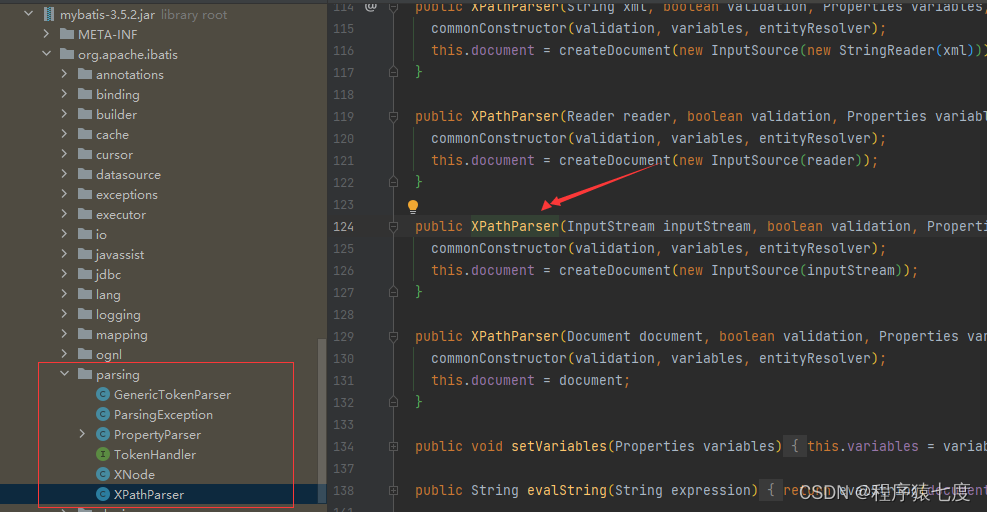
其中Mybatis对应解析包org.apache.ibatis.parsing:

XPathParser基于 Java XPath 解析器,用于解析 MyBatis中
- mybatis-config.xml
- mapper.xml
等 XML 配置文件 。
XPathParser主要内容:

继续上面的源码分析:

然后我们再回到SqlSessionFactoryBuilder中的build方法里:
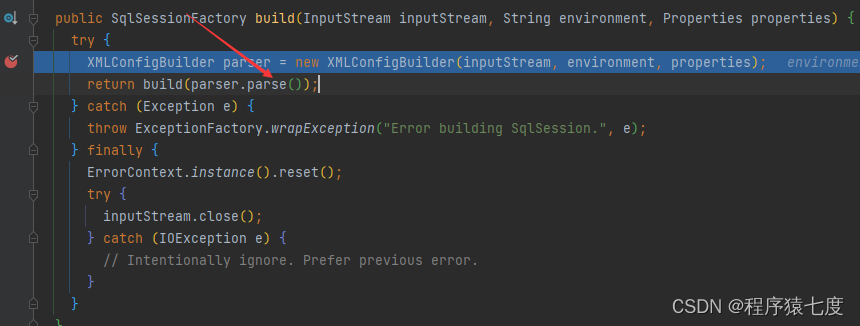
先看parser.parse()方法:

进入parseConfiguration()方法:
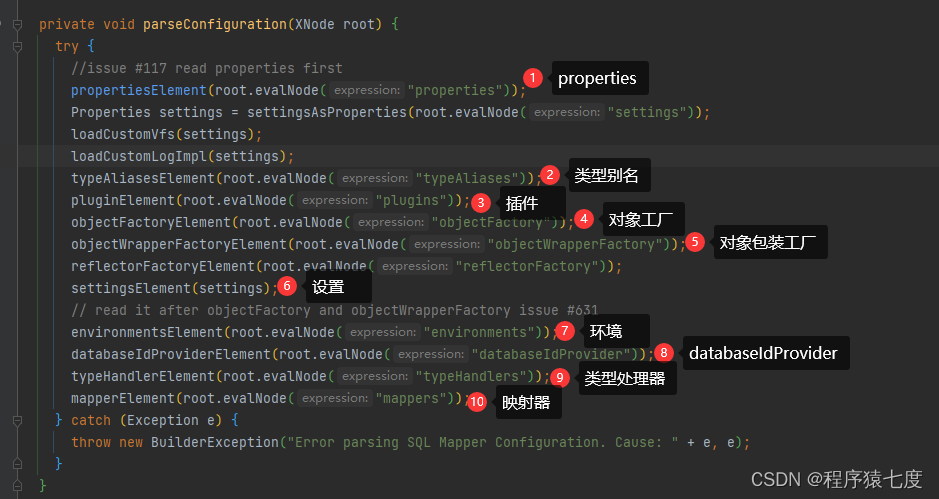
结合 mybatis-config.xml配置文件和解析方法,可以得出如何关联:

mybatis-config.xml中如果把标签当做一级标签,那么有多少个二级标签可与定义呢?
在org.apache.ibatis.builder.xml下的mybatis-3-config.dtd中已经定义了
<!ELEMENT configuration (properties?, settings?, typeAliases?, typeHandlers?, objectFactory?, objectWrapperFactory?, reflectorFactory?, plugins?, environments?, databaseIdProvider?, mappers?)>
与之对应的mybatis-config.xsd中
<xs:element name="configuration"><xs:complexType><xs:sequence><xs:element minOccurs="0" ref="properties"/><xs:element minOccurs="0" ref="settings"/><xs:element minOccurs="0" ref="typeAliases"/><xs:element minOccurs="0" ref="typeHandlers"/><xs:element minOccurs="0" ref="objectFactory"/><xs:element minOccurs="0" ref="objectWrapperFactory"/><xs:element minOccurs="0" ref="reflectorFactory"/><xs:element minOccurs="0" ref="plugins"/><xs:element minOccurs="0" ref="environments"/><xs:element minOccurs="0" ref="databaseIdProvider"/><xs:element minOccurs="0" ref="mappers"/></xs:sequence></xs:complexType></xs:element>我们最关心的Mapper.xml中能定义哪些标签,也在mybatis-3-mapper.dtd中也定义了,另外也有与之对应的 mybatis-mapper.xsd 文件中也能找到:

下面看看这些标签内容是如何存入configuration对象中?(这里例举部分,挑几个相对重要的)。
propertiesElement()源码分析:
private void propertiesElement(XNode context) throws Exception {if (context != null) {// 如果在这些地方,属性多于一个的话,MyBatis 按照如下的顺序加载它们:// 1.在 properties 元素体内指定的属性首先被读取。// 2.从类路径下资源或 properties 元素的 url 属性中加载的属性第二被读取,它会覆盖已经存在的完全一样的属性。// 3.作为方法参数传递的属性最后被读取, 它也会覆盖任一已经存在的完全一样的属性,这些属性可能是从 properties 元素体内和资源/url 属性中加载的。// 传入方式是调用构造函数时传入,public XMLConfigBuilder(Reader reader, String environment, Properties props)// 1.XNode.getChildrenAsProperties函数方便得到孩子所有PropertiesProperties defaults = context.getChildrenAsProperties();// 2.然后查找resource或者url,加入前面的PropertiesString resource = context.getStringAttribute("resource");String url = context.getStringAttribute("url");if (resource != null && url != null) {throw new BuilderException("The properties element cannot specify both a URL and a resource based property file reference. Please specify one or the other.");}if (resource != null) {defaults.putAll(Resources.getResourceAsProperties(resource));} else if (url != null) {defaults.putAll(Resources.getUrlAsProperties(url));}// 3.Variables也全部加入PropertiesProperties vars = configuration.getVariables();if (vars != null) {defaults.putAll(vars);}parser.setVariables(defaults);configuration.setVariables(defaults);}}typeAliasesElement()源码分析:
private void typeAliasesElement(XNode parent) {if (parent != null) {for (XNode child : parent.getChildren()) {if ("package".equals(child.getName())) {//如果是packageString typeAliasPackage = child.getStringAttribute("name");//(一)调用TypeAliasRegistry.registerAliases,去包下找所有类,然后注册别名(有@Alias注解则用,没有则取类的simpleName)configuration.getTypeAliasRegistry().registerAliases(typeAliasPackage);} else {//如果是typeAliasString alias = child.getStringAttribute("alias");String type = child.getStringAttribute("type");try {Class<?> clazz = Resources.classForName(type);//根据Class名字来注册类型别名//(二)调用TypeAliasRegistry.registerAliasif (alias == null) {//alias可以省略typeAliasRegistry.registerAlias(clazz);} else {typeAliasRegistry.registerAlias(alias, clazz);}} catch (ClassNotFoundException e) {throw new BuilderException("Error registering typeAlias for '" + alias + "'. Cause: " + e, e);}}}}}插件plugins解析
pluginElement()方法:(可定义多个)

Configuration中interceptorChain用来存储所有定义的插件,InterceptorChain插件链(连接链),这里使用了责任链模式。

继续看Mapper.xml是如何解析的。
mapper.xml解析
Mapper.xml在mybatis-config.xml中的配置是这样的:
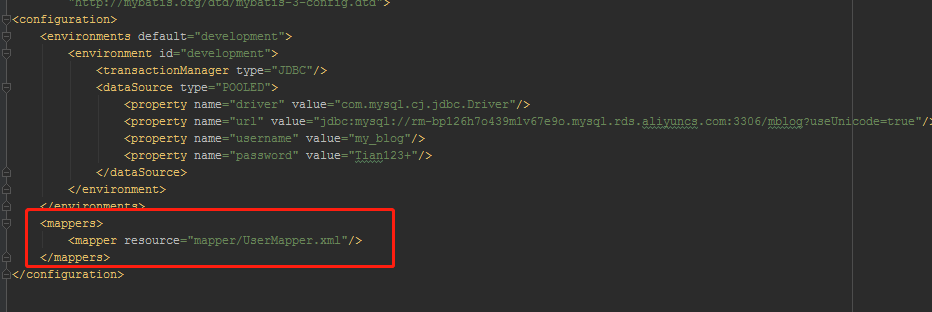
使用方式有以下四种:
<--! 1使用类路径 -->
<mappers><mapper resource="org/mybatis/builder/AuthorMapper.xml"/><mapper resource="org/mybatis/builder/BlogMapper.xml"/><mapper resource="org/mybatis/builder/PostMapper.xml"/>
</mappers>
<--! 2使用绝对url路径 -->
<mappers><mapper url="file:///var/mappers/AuthorMapper.xml"/><mapper url="file:///var/mappers/BlogMapper.xml"/><mapper url="file:///var/mappers/PostMapper.xml"/>
</mappers>
<--! 3使用java类名 -->
<mappers><mapper class="org.mybatis.builder.AuthorMapper"/><mapper class="org.mybatis.builder.BlogMapper"/><mapper class="org.mybatis.builder.PostMapper"/>
</mappers><--! 4自动扫描包下所有映射器 -->
<mappers><package name="org.mybatis.builder"/>
</mappers>源码分析:
private void mapperElement(XNode parent) throws Exception {if (parent != null) {for (XNode child : parent.getChildren()) {if ("package".equals(child.getName())) {// 10.4自动扫描包下所有映射器String mapperPackage = child.getStringAttribute("name");configuration.addMappers(mapperPackage);} else {String resource = child.getStringAttribute("resource");String url = child.getStringAttribute("url");String mapperClass = child.getStringAttribute("class");if (resource != null && url == null && mapperClass == null) {// 10.1使用类路径ErrorContext.instance().resource(resource);InputStream inputStream = Resources.getResourceAsStream(resource);// 映射器比较复杂,调用XMLMapperBuilder// 注意在for循环里每个mapper都重新new一个XMLMapperBuilder,来解析XMLMapperBuilder mapperParser = new XMLMapperBuilder(inputStream, configuration, resource, configuration.getSqlFragments());mapperParser.parse();} else if (resource == null && url != null && mapperClass == null) {// 10.2使用绝对url路径ErrorContext.instance().resource(url);InputStream inputStream = Resources.getUrlAsStream(url);// 映射器比较复杂,调用XMLMapperBuilderXMLMapperBuilder mapperParser = new XMLMapperBuilder(inputStream, configuration, url, configuration.getSqlFragments());mapperParser.parse();} else if (resource == null && url == null && mapperClass != null) {// 10.3使用java类名Class<?> mapperInterface = Resources.classForName(mapperClass);// 直接把这个映射加入配置configuration.addMapper(mapperInterface);} else {throw new BuilderException("A mapper element may only specify a url, resource or class, but not more than one.");}}}}}把这些UserMapper类似接口保存到configuration对象中。
configuration.addMapper(mapperInterface);
到这里,配置文件mybatis-config.xml和我们定义映射文件XxxMapper.xml就全部解析完成。
关于其他配置项,解析方式类似,最终都保存到了一个Configuration大对象中。
Configuration对象类似于单例模式,就是整个Mybatis中只有一个Configuration对象。
回到SqlSessionFactoryBuilder类
前面讲到了XMLConfigBuilder中的parse方法,并返回了一个Configuration对象。
build(parser.parse());
这个build方法就是传入一个Configuration对象,然后构建一个DefaultSqlSession对象。
public SqlSessionFactory build(Configuration config) {return new DefaultSqlSessionFactory(config);
}
继续回到demo代码中这一行代码里。
SqlSessionFactory sqlSessionFactory = new SqlSessionFactoryBuilder().build(inputStream);
这一行代码就相当于:
SqlSessionFactory sqlSessionFactory = new new DefaultSqlSessionFactory();
到此。配置文件解析完毕。
配置文件解析流程:

既然已经获取到了SqlSessionFactory,那么我们就可以构建SqlSession了。下面我们回到 (main)测试方法继续 来看看构建SqlSession的整个过程。
3、构建SqlSession
前面已经做了配置文件的解析,那么现在我们来构建SqlSession。
// 创建sqlSession
sqlSession = sqlSessionFactory.openSession();前面已经分析了,这里的sqlSessionFactory是DefaultSqlSessionFactory。那么此时调用的openSession()方法为DefaultSqlSessionFactory中的方法。
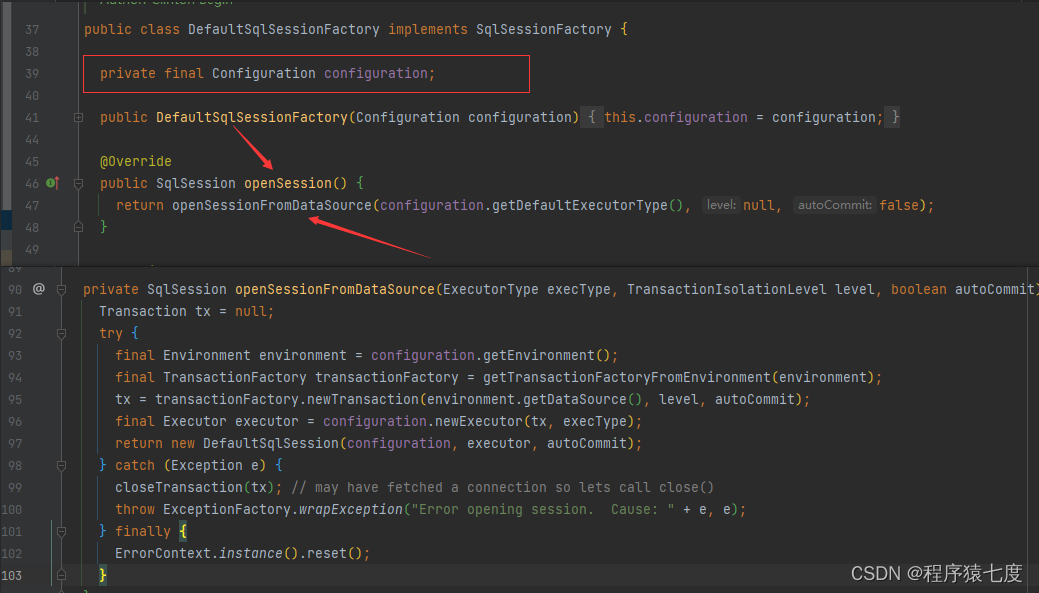
源码分析:
public class DefaultSqlSessionFactory implements SqlSessionFactory {//配置文件所有内容private final Configuration configuration;//创建session@Overridepublic SqlSession openSession() {// 调用的是另外一个openSessionFromDataSource方法return openSessionFromDataSource(configuration.getDefaultExecutorType(), null, false);}// 其实是调用这个方法//protected ExecutorType defaultExecutorType = ExecutorType.SIMPLE;private SqlSession openSessionFromDataSource(ExecutorType execType, TransactionIsolationLevel level, boolean autoCommit) {Transaction tx = null;try {// 对应xml标签<environments> ,这个在配置文件解析的时候就已经存放到configuration中了。final Environment environment = configuration.getEnvironment();// 构建事务工厂final TransactionFactory transactionFactory = getTransactionFactoryFromEnvironment(environment);// 构建一个事务对象 tx = transactionFactory.newTransaction(environment.getDataSource(), level, autoCommit);// 创建一个executor来执行SQL final Executor executor = configuration.newExecutor(tx, execType);// 创建一个DefaultSqlSession对象并返回return new DefaultSqlSession(configuration, executor, autoCommit);} catch (Exception e) {closeTransaction(tx); // may have fetched a connection so lets call close()throw ExceptionFactory.wrapException("Error opening session. Cause: " + e, e);} finally {ErrorContext.instance().reset();}}private TransactionFactory getTransactionFactoryFromEnvironment(Environment environment) {if (environment == null || environment.getTransactionFactory() == null) {return new ManagedTransactionFactory();}return environment.getTransactionFactory();}3.1 创建事务Transaction
Transaction类图:

事务工厂类型可以配置为JDBC类型或者MANAGED类型。
- JdbcTransactionFactory生产JdbcTransaction。
- ManagedTransactionFactory生产ManagedTransaction。
如果配置的JDBC,则会使用Connection对象的commit()、rollback()、close()方法来管理事务。
如果配置的是MANAGED,会把事务交给容器来管理,比如JBOSS,Weblogic。
因为是本地跑的程序,如果配置成MANAGED就会不有任何事务。
但是,如果是Spring+Mybatis,则没有必要配置,因为我们会直接在applicationContext.xml里配置数据源和事务管理器,从而覆盖Mybatis的配置。
把事务传给newExecutor()方法创建执行器Executor对象。
configuration.newExecutor(tx, execType)3.2 创建Executor
调用configuration的newExecutor方法创建Executor。
final Executor executor = configuration.newExecutor(tx, execType);
//Configuration中
public Executor newExecutor(Transaction transaction, ExecutorType executorType) {executorType = executorType == null ? defaultExecutorType : executorType;executorType = executorType == null ? ExecutorType.SIMPLE : executorType;Executor executor;//第一步if (ExecutorType.BATCH == executorType) {executor = new BatchExecutor(this, transaction);} else if (ExecutorType.REUSE == executorType) {executor = new ReuseExecutor(this, transaction);} else {executor = new SimpleExecutor(this, transaction);}//第二步if (cacheEnabled) {executor = new CachingExecutor(executor);}//第三步executor = (Executor) interceptorChain.pluginAll(executor);return executor;}此方法分三个步骤。
第一步:创建执行器
Executor的基本类型有三种:SIMPLE为默认类型。
public enum ExecutorType {SIMPLE, REUSE, BATCH
}
Executor类图:

为什么要让抽象类BaseExecutor实现Executor接口,然后让具体实现类继承抽象类呢?
这就是模板方法模式的实现。
模板方法模式就是定义一个算法骨架,并允许子类为一个或者多个步骤提供实现。模板方法是得子类可以再不改变算法结构的情况下,重新定义算法的某些步骤。
抽象方法是在子类汇总实现的,每种执行器自己实现自己的逻辑,BaseExecutor最终会调用到具体的子类。
抽象方法


第二步:缓存装饰
在上面代码中的第二步
if (cacheEnabled) {executor = new CachingExecutor(executor);
}
如果cacheEnabled=true,会用装饰器设计模式对Executor进行装饰。
第三步:插件代理
缓存装饰完后,就会执行
executor = (Executor) interceptorChain.pluginAll(executor);
这里会对Executor植入插件逻辑。
比如:分页插件中就需要把插件植入的Executor

好了,到此,执行器创建的就搞定了
Executor创建完毕后,就该创建DefaultSqlSession了,代码:
// 创建一个DefaultSqlSession对象并返回
return new DefaultSqlSession(configuration, executor, autoCommit);
进入DefaultSqlSession的构造方法中:

DefaultSqlSession中包含两个重要属性:

自此,SqlSession对象构建完毕。
sqlSession = sqlSessionFactory.openSession();
这里的sqlSession就是:
sqlSession = new DefaultSqlSession();
整个构建过程:

4、获取UserMapper接口的代理对象
前面已经知道Mybatis配置文件解析到获取SqlSession,下面分析从SqlSession到userMapper:
// 创建userMapper对象(UserMapper并没有实现类)
UserMapper userMapper = sqlSession.getMapper(UserMapper.class);已经知道了这里的sqlSession使用的是默认实现类DefaultSqlSession。
直接进入DefaultSqlSession的getMapper方法。

这里有三个疑问:

问题1:getMapper返回的是个什么对象?
可以看出,getMapper方法调用的是Configuration中的getMapper方法。然后进入Configuration中

// 在Configuration类中
protected final MapperRegistry mapperRegistry = new MapperRegistry(this);
// type=UserMapper.class
public <T> T getMapper(Class<T> type, SqlSession sqlSession) {return mapperRegistry.getMapper(type, sqlSession);
}这里也没做什么,继续调用MapperRegistry中的getMapper:
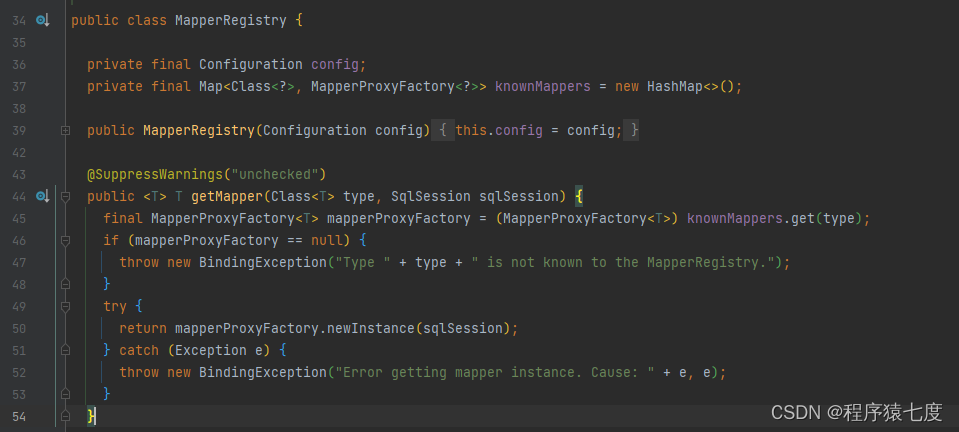
源码分析:
// MapperRegistry中
public class MapperRegistry {// 主要是存放配置信息private final Configuration config;// MapperProxyFactory 的映射private final Map<Class<?>, MapperProxyFactory<?>> knownMappers = new HashMap<>();// 获得 Mapper Proxy 对象//type=UserMapper.class,session为当前会话public <T> T getMapper(Class<T> type, SqlSession sqlSession) {// 这里是get,那就有add或者putfinal MapperProxyFactory<T> mapperProxyFactory = (MapperProxyFactory<T>) knownMappers.get(type);if (mapperProxyFactory == null) {throw new BindingException("Type " + type + " is not known to the MapperRegistry.");}try {// 创建实例return mapperProxyFactory.newInstance(sqlSession);} catch (Exception e) {throw new BindingException("Error getting mapper instance. Cause: " + e, e);}}// 解析配置文件的时候就会调用这个方法,// type=UserMapper.classpublic <T> void addMapper(Class<T> type) {// 判断 type 必须是接口,也就是说 Mapper 接口。if (type.isInterface()) {// 已经添加过,则抛出 BindingException 异常if (hasMapper(type)) {throw new BindingException("Type " + type + " is already known to the MapperRegistry.");}boolean loadCompleted = false;try {// 添加到 knownMappers 中knownMappers.put(type, new MapperProxyFactory<>(type));// 创建 MapperAnnotationBuilder 对象,解析 Mapper 的注解配置MapperAnnotationBuilder parser = new MapperAnnotationBuilder(config, type);parser.parse();// 标记加载完成loadCompleted = true;} finally {// 若加载未完成,从 knownMappers 中移除if (!loadCompleted) {knownMappers.remove(type);}}}
}
}MapperProxyFactory对象里保存了mapper接口的class对象,就是一个普通的类,没有什么逻辑。
在这个类里可以理解使用了单例模式methodCache(注册式单例模式), 和工厂模式getMapper()。
public class MapperProxyFactory<T> {private final Class<T> mapperInterface;private final Map<Method, MapperMethod> methodCache = new ConcurrentHashMap<>();public MapperProxyFactory(Class<T> mapperInterface) {this.mapperInterface = mapperInterface;}public Class<T> getMapperInterface() {return mapperInterface;}public Map<Method, MapperMethod> getMethodCache() {return methodCache;}@SuppressWarnings("unchecked")protected T newInstance(MapperProxy<T> mapperProxy) {// 最终以JDK动态代理创建对象并返回return (T) Proxy.newProxyInstance(mapperInterface.getClassLoader(), new Class[] { mapperInterface }, mapperProxy);}public T newInstance(SqlSession sqlSession) {// 创建 MapperProxy 对象final MapperProxy<T> mapperProxy = new MapperProxy<>(sqlSession, mapperInterface, methodCache);return newInstance(mapperProxy);}}返回到 MapperRegistry类中 getMapper 方法,继续看这行重点代码:

return mapperProxyFactory.newInstance(sqlSession);newInstance()方法:
依然是基于 JDK Proxy 实现,而 InvocationHandler 参数是 MapperProxy 对象。
// loader 是 UserMapper 的类加载器
// interfaces 是 UserMapper
// h 是 mapperProxy 对象
public static Object newProxyInstance(ClassLoader loader,Class<?>[] interfaces,InvocationHandler h){.....
}问题2:为什么就可以调用他的方法?
上面调用newInstance方法时候创建了MapperProxy对象,并且是当做newProxyInstance的第三个参数,所以MapperProxy类肯定实现了InvocationHandler。

进入MapperProxy类中:
// 果然实现了InvocationHandler接口
public class MapperProxy<T> implements InvocationHandler, Serializable {private static final long serialVersionUID = -6424540398559729838L;private final SqlSession sqlSession;private final Class<T> mapperInterface;private final Map<Method, MapperMethod> methodCache;public MapperProxy(SqlSession sqlSession, Class<T> mapperInterface, Map<Method, MapperMethod> methodCache) {this.sqlSession = sqlSession;this.mapperInterface = mapperInterface;this.methodCache = methodCache;}// 调用 userMapper.selectById() 实质上是调用这个invoke方法@Overridepublic Object invoke(Object proxy, Method method, Object[] args) throws Throwable {try {// 代理以后,所有Mapper的方法调用时,都会调用这个invoke方法// 并不是任何一个方法都需要执行调用代理对象进行执行,如果这个方法是Object中通用的方法(toString、hashCode等)无需执行if (Object.class.equals(method.getDeclaringClass())) {return method.invoke(this, args);} else if (method.isDefault()) {// JDK8以后的接口默认实现方法 return invokeDefaultMethod(proxy, method, args);}} catch (Throwable t) {throw ExceptionUtil.unwrapThrowable(t);}// 这里优化了,去缓存中找MapperMethod// 创建MapperMethod对象final MapperMethod mapperMethod = cachedMapperMethod(method);// 执行(会去根据insert|update|delete|select 4种情况,分别调用SqlSession的4大类方法)return mapperMethod.execute(sqlSession, args);}
}其中 mapperMethod.execute(sqlSession, args) :
public Object execute(SqlSession sqlSession, Object[] args) {Object result;// 可以看到执行时就是4种情况,insert|update|delete|select,分别调用SqlSession的4大类方法if (SqlCommandType.INSERT == command.getType()) {Object param = method.convertArgsToSqlCommandParam(args);result = rowCountResult(sqlSession.insert(command.getName(), param));} else if (SqlCommandType.UPDATE == command.getType()) {Object param = method.convertArgsToSqlCommandParam(args);result = rowCountResult(sqlSession.update(command.getName(), param));} else if (SqlCommandType.DELETE == command.getType()) {Object param = method.convertArgsToSqlCommandParam(args);result = rowCountResult(sqlSession.delete(command.getName(), param));} else if (SqlCommandType.SELECT == command.getType()) {if (method.returnsVoid() && method.hasResultHandler()) {// 如果有结果处理器executeWithResultHandler(sqlSession, args);result = null;} else if (method.returnsMany()) {// 如果结果有多条记录result = executeForMany(sqlSession, args);} else if (method.returnsMap()) {// 如果结果是mapresult = executeForMap(sqlSession, args);} else {// 否则就是一条记录Object param = method.convertArgsToSqlCommandParam(args);result = sqlSession.selectOne(command.getName(), param);}} else {throw new BindingException("Unknown execution method for: " + command.getName());}if (result == null && method.getReturnType().isPrimitive() && !method.returnsVoid()) {throw new BindingException("Mapper method '" + command.getName() + " attempted to return null from a method with a primitive return type (" + method.getReturnType() + ").");}return result;}也就是说,getMapper方法返回的是一个JDK动态代理对象(类型是$Proxy+数字)。这个代理对象会继承Proxy类,实现被代理的接口UserMpper,里面持有了一个MapperProxy类型的触发管理类。
当调用UserMpper的方法时候,实质上调用的是MapperProxy的invoke方法。userMapper=$Proxy6@3252。

现在回答前面的问题:
为什么要在MapperRegistry中保存一个工厂类,原来他是用来创建并返回代理类的。这里是代理模式的一个非常经典的应用。
MapperProxy如何实现对接口的代理?
我们知道,JDK动态代理有三个核心角色:
- 被代理类(即就是实现类)
- 接口
- 实现了InvocationHanndler的触发管理类,用来生成代理对象。
被代理类必须实现接口,因为要通过接口获取方法,而且代理类也要实现这个接口。
而Mybatis中并没有Mapper接口的实现类,怎么被代理呢?它忽略了实现类,直接对Mapper接口进行代理。
MyBatis动态代理:
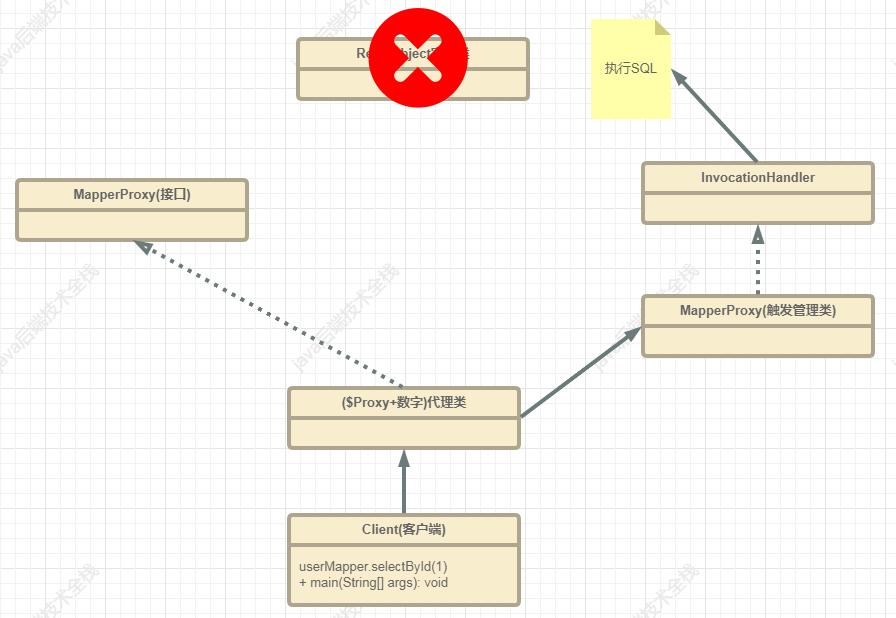
在Mybatis中,JDK动态代理为什么不需要实现类呢?
这里我们的目的其实就是根据一个可以执行的方法,直接找到Mapper.xml中statement ID ,方便调用。
最后返回的userMapper是MapperProxyFactory创建的代理对象,这个对象中包含MapperProxy对象。
问题3:到底是怎么根据 Mapper.java 找到 Mapper.xml 的?
最后调用userMapper.selectUserById(),本质上调用的是MapperProxy的invoke()方法。
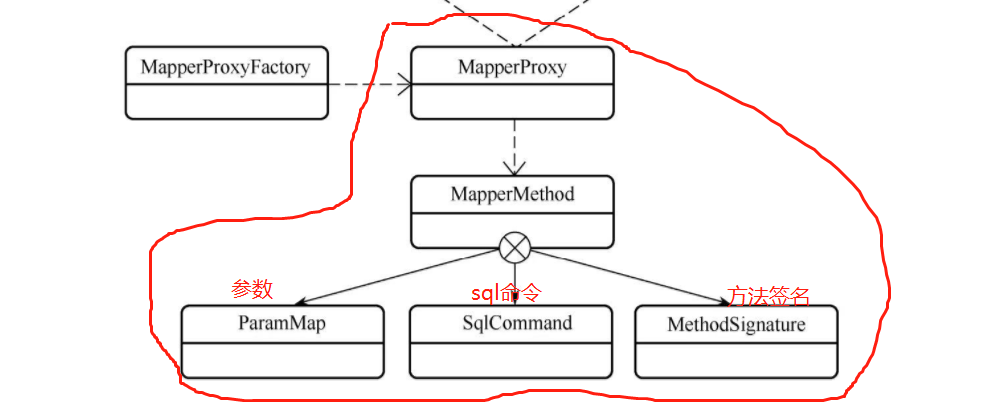
如果根据(接口+方法名找到Statement ID ),这个逻辑在InvocationHandler子类(MapperProxy类)中就可以完成了,其实也就没有必要在用实现类了。
整个流程

自此,我们已经拿到了UserMapper接口的代理对象。接下来我们就去调用这个代理对象的方法。
5、UserMapp中的方法和SQL如何关联
User user = userMapper.selectById(1));
通过前面的分析,我们已经知道了userMapper是通过动态代理生成的代理对象,
所以调用这个代理对象的任意方法都是执行触发管理类MapperProxy的invoke()方法。
分为两部分:
1、MapperProxy.invoke() 到 Executor.query(方法和SQL关联)。
2、Executor.query 到 JDBC 中的SQL执行。
第一部分流程图:
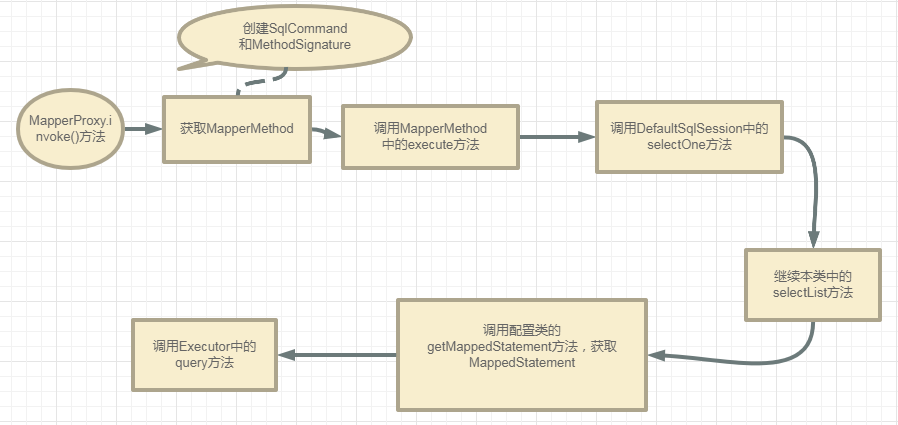
MapperProxy.invoke()
先来看看这个invoke()方法里有些什么逻辑。
//MapperProxy类
@Override
public Object invoke(Object proxy, Method method, Object[] args) throws Throwable {try {//首先判断是否为Object本身的方法,是则不需要去执行SQL,//比如:toString()、hashCode()等方法。if (Object.class.equals(method.getDeclaringClass())) {return method.invoke(this, args);} else if (method.isDefault()) {//判断是否JDK8以后的接口默认实现方法。return invokeDefaultMethod(proxy, method, args);}} catch (Throwable t) {throw ExceptionUtil.unwrapThrowable(t);}//<3> final MapperMethod mapperMethod = cachedMapperMethod(method);//<4>return mapperMethod.execute(sqlSession, args);
}从缓存获取MapperMethod,这里加入了缓存主要是为了提升MapperMethod的获取速度。这个设计非常的有意思,缓存的使用在Mybatis中也是非常之多。
private final Map<Method, MapperMethod> methodCache;
private MapperMethod cachedMapperMethod(Method method) {return methodCache.computeIfAbsent(method, k -> new MapperMethod(mapperInterface, method, sqlSession.getConfiguration()));}Map的computeIfAbsent方法:根据key获取值,如果值为null,则把后面的Object的值付给key。
继续看MapperMethod这个类,定义了两个属性command和method,以及两个静态内部类。
public class MapperMethod {private final SqlCommand command;private final MethodSignature method;public static class SqlCommand {private final String name;private final SqlCommandType type;public SqlCommand(Configuration configuration, Class<?> mapperInterface, Method method) {final String methodName = method.getName();final Class<?> declaringClass = method.getDeclaringClass();//获得 MappedStatement 对象MappedStatement ms = resolveMappedStatement(mapperInterface, methodName, declaringClass,configuration);// <2> 找不到 MappedStatementif (ms == null) {// 如果有 @Flush 注解,则标记为 FLUSH 类型if (method.getAnnotation(Flush.class) != null) {name = null;type = SqlCommandType.FLUSH;} else { // 抛出 BindingException 异常,如果找不到 MappedStatement//(开发中容易见到的错误)说明该方法上,没有对应的 SQL 声明。throw new BindingException("Invalid bound statement (not found): "+ mapperInterface.getName() + "." + methodName);}//找到 MappedStatement} else {// 获得 name//id=com.tian.mybatis.mapper.UserMapper.selectByIdname = ms.getId();// 获得 type=SELECTtype = ms.getSqlCommandType();//如果type=UNKNOWNif (type == SqlCommandType.UNKNOWN) { // 抛出 BindingException 异常,如果是 UNKNOWN 类型throw new BindingException("Unknown execution method for: " + name);}}} private MappedStatement resolveMappedStatement(Class<?> mapperInterface, String methodName,Class<?> declaringClass, Configuration configuration) {// 获得编号//com.tian.mybatis.mapper.UserMapper.selectByIdString statementId = mapperInterface.getName() + "." + methodName;//如果有,获得 MappedStatement 对象,并返回if (configuration.hasStatement(statementId)) {//mappedStatements.get(statementId); //解析配置文件时候创建并保存Map<String, MappedStatement> mappedStatements中return configuration.getMappedStatement(statementId);// 如果没有,并且当前方法就是 declaringClass 声明的,则说明真的找不到} else if (mapperInterface.equals(declaringClass)) {return null;}// 遍历父接口,继续获得 MappedStatement 对象for (Class<?> superInterface : mapperInterface.getInterfaces()) {if (declaringClass.isAssignableFrom(superInterface)) {MappedStatement ms = resolveMappedStatement(superInterface, methodName,declaringClass, configuration);if (ms != null) {return ms;}}}// 真的找不到,返回 nullreturn null;} //....}
public static class MethodSignature {private final boolean returnsMap;private final Class<?> returnType;private final Integer rowBoundsIndex;//....
}
SqlCommand封装了statement ID,比如说:
com.tian.mybatis.mapper.UserMapper.selectById和SQL类型。
public enum SqlCommandType {
UNKNOWN, INSERT, UPDATE, DELETE, SELECT, FLUSH;
}另外还有个属性MethodSignature,主要是封装的是返回值的类型和方法入参。这里我们debug看看这个MapperMethod对象返回的内容和我们案例中代码的关联。
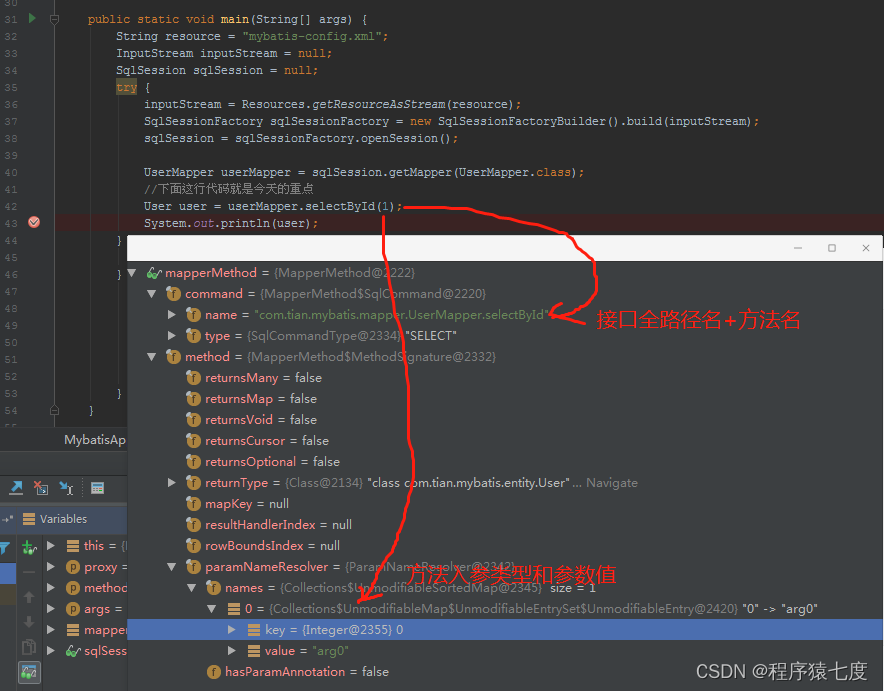
接着看MapperMethod中execute方法。
MapperMethod.execute()
先来看看这个方法的整体逻辑:
public Object execute(SqlSession sqlSession, Object[] args) {Object result;switch (command.getType()) {case SELECT://部分代码省略Object param = method.convertArgsToSqlCommandParam(args);//本次是QUERY类型,所以这里是重点 result = sqlSession.selectOne(command.getName(), param);if (method.returnsOptional()&& (result == null || !method.getReturnType().equals(result.getClass()))) {result = Optional.ofNullable(result);}break;default:throw new BindingException("Unknown execution method for: " + command.getName());} return result;}这个方法中,根据我们上面获得的不同的type(INSERT、UPDATE、DELETE、SELECT)和返回类型:
1.调用convertArgsToSqlCommandParam()将方法参数转换为SQL的参数。
2.调用sqlSession的insert()、update()、dalete()、selectOne()方法。
我们这个案例是查询,这里回到了DefaultSqlSession中selectOne方法中。
SqlSession.selectOne()
//DefaultSqlSession中
@Override
public <T> T selectOne(String statement, Object parameter) {//这是一种好的设计方法//不管是执行多条查询还是单条查询,都走selectList方法(重点)List<T> list = this.selectList(statement, parameter);if (list.size() == 1) {//如果只有一条就返回第一条return list.get(0);} else if (list.size() > 1) {//(开发中常见错误)方法定义的是返回一条数据,结果查出了多条数据,就会报这个异常throw new TooManyResultsException("Expected one result (or null) to be returned by selectOne(), but found: " + list.size());} else {//数据库中没有数据就返回nullreturn null;}}这里调用的是selectList方法。
@Override
public <E> List<E> selectList(String statement, Object parameter) {return this.selectList(statement, parameter, RowBounds.DEFAULT);}@Overridepublic <E> List<E> selectList(String statement, Object parameter, RowBounds rowBounds) {try {//从configuration获取MappedStatement//此时的statement=com.tian.mybatis.mapper.UserMapper.selectByIdMappedStatement ms = configuration.getMappedStatement(statement);//调用执行器中的query方法return executor.query(...);} catch (Exception e) {//.....} finally {ErrorContext.instance().reset();}}在这个方法里是根据statement从configuration对象中获取MappedStatement。
MappedStatement ms = configuration.getMappedStatement(statement);在configuration中getMappedStatement方法:
//存放在一个map中的
//key是statement=com.tian.mybatis.mapper.UserMapper.selectById,value是MappedStatement
protected final Map<String, MappedStatement> mappedStatements = new StrictMap<MappedStatement>(); public MappedStatement getMappedStatement(String id) {return this.getMappedStatement(id, true);}
public MappedStatement getMappedStatement(String id, boolean validateIncompleteStatements) { return mappedStatements.get(id);
}而MappedStatement里面有xml中增删改查标签配置的所有属性,包括id、statementType、sqlSource、入参、返回值等。

到此,我们UserMapper类中的方法已经和UserMapper.xml中的sql给彻底关联起来了。继续
executor.query(ms, wrapCollection(parameter), rowBounds, Executor.NO_RESULT_HANDLER);这里执行的是执行器Executor中的query()方法。
Executor.query()方法
这里的Executor对象是在调用openSession方法的时候创建的。
下面来看看调用执行器的query()放的整个流程(第二部分流程):

下面看看具体源码是如何实现的。
CachingExecutor.query()
在CachingExecutor中
@Override
public <E> List<E> query(MappedStatement ms, Object parameterObject, RowBounds rowBounds, ResultHandler resultHandler) throws SQLException {BoundSql boundSql = ms.getBoundSql(parameterObject);CacheKey key = createCacheKey(ms, parameterObject, rowBounds, boundSql);return query(ms, parameterObject, rowBounds, resultHandler, key, boundSql);
}BoundSql中主要是SQL和参数:

既然是缓存,可以想到key-value数据结构。
下面来看看这个key生成规则:
这个二级缓存是怎么构成的呢?并且还要保证在查询的时候必须是唯一。
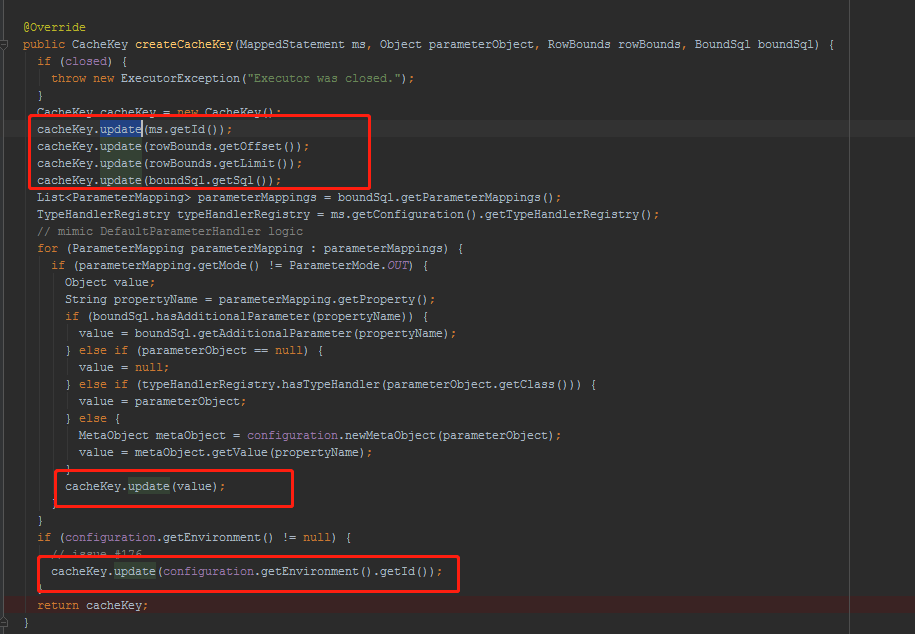
也就说,构成key主要有:
方法相同、翻页偏移量相同、SQL相同、参数相同、数据源环境相同才会被认为是同一个查询。

这里大家知道这个层面就已经阔以了。如果向更深入的搞,就得把hashCode这些扯进来了,请看上面这个张图里前面的几个属性。
处理二级缓存
首先是从ms中取出cache对象,判断cache对象是否为null,如果为null,则没有查询二级缓存和写入二级缓存的流程。
@Override
public <E> List<E> query(MappedStatement ms, Object parameterObject, RowBounds rowBounds, ResultHandler resultHandler, CacheKey key, BoundSql boundSql)throws SQLException {Cache cache = ms.getCache();//判断是否有二级缓存if (cache != null) {flushCacheIfRequired(ms);if (ms.isUseCache() && resultHandler == null) {ensureNoOutParams(ms, boundSql);@SuppressWarnings("unchecked")List<E> list = (List<E>) tcm.getObject(cache, key);if (list == null) {list = delegate.query(ms, parameterObject, rowBounds, resultHandler, key, boundSql);tcm.putObject(cache, key, list); // issue #578 and #116}return list;}}return delegate.query(ms, parameterObject, rowBounds, resultHandler, key, boundSql);
}那么这个Cache对象是什么创建的呢?
二级缓存如何开启?
配置项:
<configuration><settings><setting name="cacheEnabled" value="true|false" /></settings>
</configuration>cacheEnabled=true表示二级缓存可用,但是要开启话,需要在Mapper.xml内配置。
<cache eviction="FIFO" flushInterval="60000" size="512" readOnly="true"/>
<!--或者 简单方式-->
<cache/>对配置项属性说明:
- flushInterval="60000",间隔60秒清空缓存,这个间隔60秒,是被动触发的,而不是定时器轮询的。
- size=512,表示队列最大512个长度,大于则移除队列最前面的元素,这里的长度指的是CacheKey的个数,默认为1024。
- readOnly="true",表示任何获取对象的操作,都将返回同一实例对象。如果readOnly="false",则每次返回该对象的拷贝对象,简单说就是序列化复制一份返回。
- eviction:缓存会使用默认的Least Recently Used(LRU,最近最少使用的)算法来收回。FIFO:First In First Out先进先出队列。
在解析Mapper.xml的XMLMapperBuilder类中的cacheElement()方法里。

解析二级缓存中的标签:

创建Cache对象:
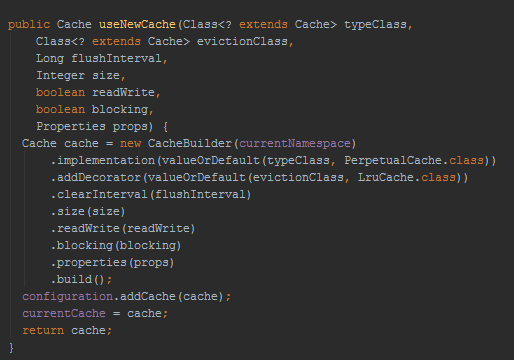
二级缓存处理完了,就来到BaseExecutor的query方法中。
BaseExecutor.query()
第一步,清空缓存
if (queryStack == 0 && ms.isFlushCacheRequired()) {clearLocalCache();
}queryStack用于记录查询栈,防止地柜查询重复处理缓存。
flushCache=true的时候,会先清理本地缓存(一级缓存)。
如果没有缓存会从数据库中查询
list = queryFromDatabase(ms, parameter, rowBounds, resultHandler, key, boundSql);在看看这个方法的逻辑:
private <E> List<E> queryFromDatabase(...) throws SQLException {List<E> list;//使用占位符的方式,先抢占一级缓存。localCache.putObject(key, EXECUTION_PLACEHOLDER);try {list = doQuery(ms, parameter, rowBounds, resultHandler, boundSql);} finally {//删除上面抢占的占位符 localCache.removeObject(key);}//放入一级缓存中localCache.putObject(key, list);return list;
}先在缓存使用占位符占位,然后查询,移除占位符,将数据放入一级缓存中。
执行Executor的doQuery()方法,默认使用SimpleExecutor。
list = doQuery(ms, parameter, rowBounds, resultHandler, boundSql);下面就来到了SimpleExecutor中的doQuery方法。
SimpleExecutor.doQuery
@Override
public <E> List<E> doQuery(....) throws SQLException {Statement stmt = null;try {//获取配置文件信息 Configuration configuration = ms.getConfiguration();//获取handlerStatementHandler handler = configuration.newStatementHandler(....);//获取Statementstmt = prepareStatement(handler, ms.getStatementLog());//执行RoutingStatementHandler的query方法 return handler.query(stmt, resultHandler);} finally {closeStatement(stmt);}
}创建StatementHandler
在configuration中newStatementHandler()里,创建了一个StatementHandler,先得到RoutingStatementHandler(路由)。
public StatementHandler newStatementHandler() {StatementHandler statementHandler = new RoutingStatementHandler//执行StatementHandler类型的插件 statementHandler = (StatementHandler) interceptorChain.pluginAll(statementHandler);return statementHandler;
}RoutingStatementHandler创建的时候是用来创建基本的StatementHandler的。这里会根据MapperStament里面的statementType决定StatementHandler类型。

默认是PREPARED。
StatementHandler里面包含了处理参数的ParameterHandler和处理结果集的ResultHandler。

上面说的这几个对象正式被插件拦截的四大对象,所以在创建的时都要用拦截器进行包装的方法。
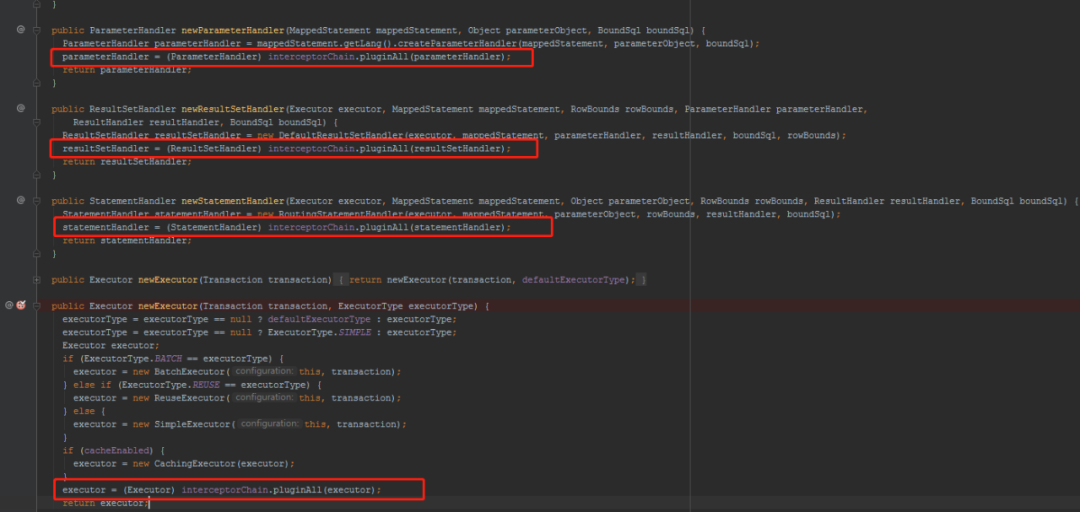
对于插件相关的,请看前面发的插件的文章。
创建Statement

创建对象后就会执行RoutingStatementHandler的query方法。
//RoutingStatementHandler中
@Override
public <E> List<E> query(Statement statement, ResultHandler resultHandler) throws SQLException {//委派delegate=PreparedStatementHandlerreturn delegate.query(statement, resultHandler);
}这里设计很有意思,所有的处理都要使用RoutingStatementHandler来路由,全部通过委托的方式进行调用。
然后执行到PreparedStatementHandler中的query方法。
@Override
public <E> List<E> query(Statement statement, ResultHandler resultHandler) throws SQLException {PreparedStatement ps = (PreparedStatement) statement;//JDBC的流程了 ps.execute();//处理结果集,如果有插件代理ResultHandler,会先走到被拦截的业务逻辑中return resultSetHandler.handleResultSets(ps);
}看到了ps.execute();表示已经到JDBC层面了,这时候SQL就已经执行了。后面就是调用DefaultResultSetHandler类进行处理。
到这里,SQL语句就执行完毕,并将结果集赋值并返回了。
总结
本文从一个案例代码出发,到解析Mybatis的配置文件,到创建SqlSession对象,到获取UserMapper接口的代理对象,到调用代理对象方法,再到让方法和SQL关联起来,最后执行SQL,返回结果集。
涉及到的设计模式:单例模式、建造者设计模式、模板方法模式、代理模式、装饰器模式等。
整个流程
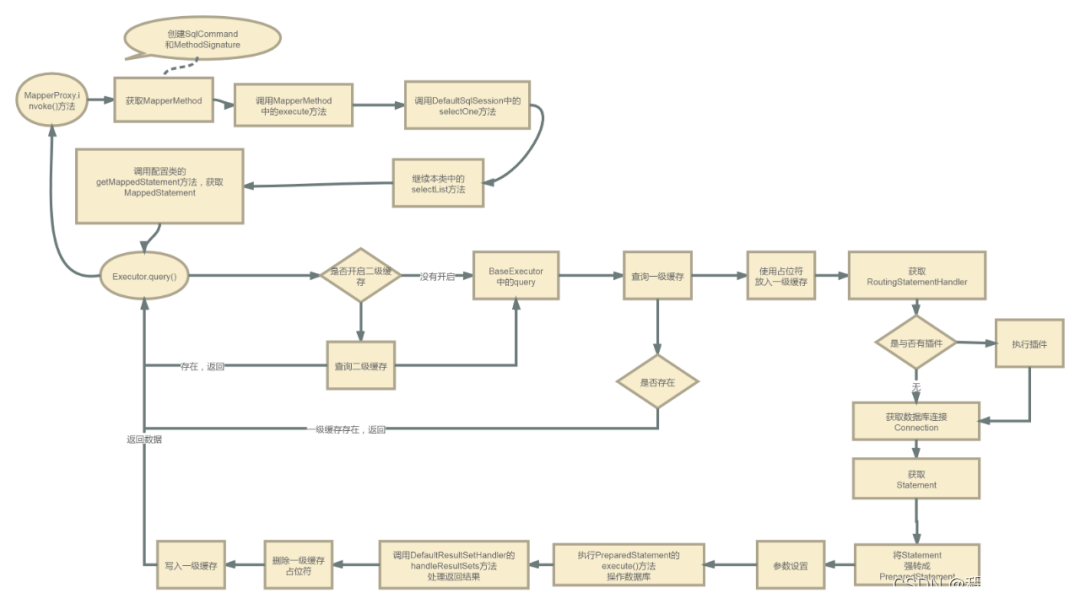
从调用userMapper的selectById()方法开始,到JDBC中SQL执行的整个流程图。
感兴趣的建议对照着这张流程图就行一步一步的debug。
👍如果对你有帮助,给博主一个免费的点赞以示鼓励
欢迎各位🔎点赞👍评论收藏⭐️

)






和GetOutput()的区别)






——安卓广播机制)
、459.重复的子字符串、字符串总结、双指针回顾)


